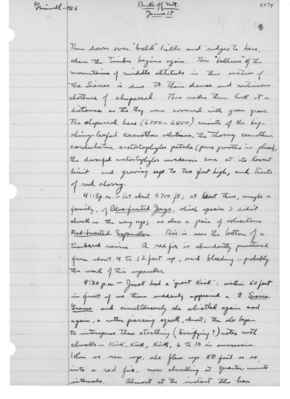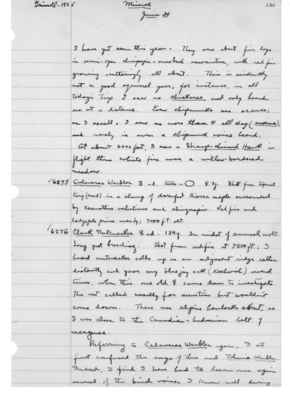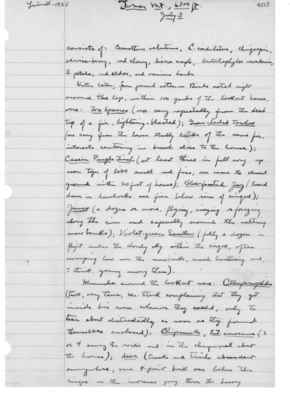Pages That Mention ceanothus velutinus
1925: Joseph Grinnell's field notes
S2 Page 19
Collector: Grinnell - 1925 Location: Lassen Section (Brokeoff Mt.) Date: June 17, 1925 Page Number: 2474
Then down over "bald" hills and ridges to here, where the Timber begins again. This "baldness" of the mountains of middle altitude in this section of the Sierras is due to their dense and continuous clothure of chaparral. This makes them look at a distance as tho they were covered with green grass. The chaparral here (6000-6500) consists of the big shiny-leafed ceanothus velutinus, the thorny ceanothus condulatus, arctostaphylos patula (pure growths in places), the dwarfed arctostaphylos nevadensis here at its lowest limit and growing up to two feet high, and tracts of red cherry. 4:15 p.m. - At about 6700 ft.; at least there, maybe a family, of Blue-fronted Jays, which species I didn't check on the way up; as also a pair of solicitous Red-breasted Sapsuckers. This is near the bottom of a timbered ravine. A red fir is abundantly punctured from about 4 to 12 feet up, and bleeding - probably the work of this sapsucker. 4:30 p.m. - Just had a "great kick": within 50 feet in front of us there suddenly appeared a female Sierra Grouse and simultaneously she whistled again and again, a rather piercing squall, almost; then she began to intersperse these startling (terrifying?) notes with clucks - kirk, kirk, kirk, 6 to 10 in succession. When we ran up, she flew up 80 feet or so into a red fir, now clucking at quarter-minute intervals. Almost at the instant the hen
S2 Page 58
Collector: Grinnell - 1925 Location: Mineral Date: June 30 Page Number: 2511
I have yet seen this year. They were about fir logs in semi-open chinquapin-snowbush association, with red fir growing scatteringly all about. This is evidently not a good squirrel year; for instance, in all today's trip I saw no chickaree, and only heard one at a distance. Even chipmunks are scarce; as I recall, I saw no more than 4 all day (amoenus), and rarely is even a chipmunk voice heard.
At about 6000 feet, I saw a Sharp-shinned Hawk in flight thru the white firs near a willow-bordered meadow.
6275 Calaveras Warbler [male symbol] ad. testes - [testes illustration] 8.3 g, Shot from topmost twig (dead) in a clump of dwarfed Sierra maple surrounded by ceanothus velutinus and chinquapin. Red firs and lodgepole pine nearby; 7000 ft. alt.
6276 Clark Nutcracker [female symbol] ad. 134 g. In midst of annual molt. Long past breeding. Shot from red fir at 7500 ft.: I heard nutcracker calls up on an adjacent ridge rather distantly and gave my bluejay call (Kochwish) several times, when this one old [female symbol] came down to investigate. The rest called nasally for sometime but wouldn't come down. There were alpine hemlocks about, so I was close to the Canadian-hudsonian belt of mergence.
Referring to the Calaveras Warbler again, I at first confused the songs of this and Tolmie Warbler. Indeed, I find I have had to learn over again several of the bird voices I knew well during
S2 Page 64
Collector: Grinnell - 1925 Location: Turner Mt., 6300 ft. Date: July 3 Page Number: 2517
consist of: Ceanothus velutinus, C. cordulatus, chinquapin, service-berry, red cherry, Sierra maple, Arctostaphylos nevadensis, A. patula, red alder, and various herbs.
Written later, from pencil notes. - Birds noted right around the top, within 100 yards of the lookout house, were: Fox Sparrow (one sang repeatedly from the dead tip of a fir, lightning-blasted); Green-tailed Towhee (one sang from the lower stubby limbs of the same fir, interests centering in the brush close to the house); Cassin Purple Finch (at least three in full song up near tops of live small red firs, one came to cleared ground within 20 feet of house); Blue-fronted Jay (heard down in the hemlocks and firs below rim of cirque); Junco (a dozen or more, flying, singing or foraging along the rim and especially around the melting snow banks); Violet-green Swallow (fully a dozen in flight under the cloudy sky within the cirque, often swooping low over the snowbanks, much twittering and, I think, young among them.
Mammals around the lookout were: Callospermophilus (two, very tame, Mr. Stark complaining that they got inside his room whenever they could, only to tear about distractedly as soon a they found themselves enclosed), Chipmunks, Eut. amoenus (3 or 4 among the rocks and in the chaparral about the house); deer (tracks and tails abundant everywhere, one 4-point buck seen below the cirque on the moraines going thru [sic] the heavy


